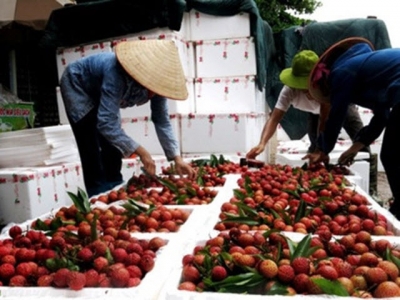Plenty of opportunities for fruit and veg to meet Japans needs

Exports of Vietnamese fruit and vegetables to Japan have grown strongly in recent times, especially when it comes to stone fruits. However, the market share in Japan’s total imports is still quite low when compared to the estimated potential for sales of Vietnamese fruit and vegetables on the market.
According to statistics from the General Department of Vietnam Customs, from early this year, Japan has been among the top three importers of Vietnamese fruit and vegetables, after China and the US, with an import value hitting an estimated US$1.7 billion in five months, a year-on-year rise of 19.7%.
Japan Customs says the country’s imports of Vietnamese fruits rose 7.9% to US$718.2 million in the first quarter of this year.
As an experienced and successful exporter of fruit and vegetables to Japan, Le Van Cuong, director of Da Lat Gap Ltd Company, says the biggest difficulty when selling to Japan is the quality of products. Fruit and vegetables are exported at high prices but they must meet the country’s strict requirements.
Exported fruit and vegetables must have a Global GAP certificate. Businesses are compelled to apply hi-tech procedures at enormous cost to produce high quality products, which poses a big risk for them. However, if the investment pays off and their products do well, they have more chance to expand to other markets, says Mr Cuong.
The Import-Export Department under the Ministry of Industry and Trade reports that Vietnam has recently shipped red dragon fruit, mangoes, lychees, balm-mint leaf and parsley to Japan. Meanwhile, the Japanese agricultural industry is facing a lot of challenges such as an aging population and young people who do not want to work in agriculture. It is forecast that Japan’s demand for imports of fruit and vegetables will keep rising in the future, offering a huge opportunity for Vietnamese businesses to increase their exports of fruit and vegetables to the lucrative market.
Tran Thanh Hai, deputy head of the Import-Export Department highlights Japan as one of countries applying systems of stringent criteria for the quality of products and on food hygiene and safety. Most of their criteria are equal to or exceed regular international standards.
It’s noteworthy that the quality criteria are adopted in line with World Trade Organization (WTO) principles, showing that they do not discriminate between domestic and imported goods. Therefore, Vietnamese businesses must meet all of the strict requirements to enter the market, says Mr Hai.
Mr Hai says the high cost of transportation is one of the main obstacles to the success of Vietnam’s exports, as it can negatively affect the country’s export advantage and reduce the competitiveness of Vietnamese products in terms of prices compared to other markets.
To boost exports to Japan, businesses will have to find ways to reduce the cost of transportation to improve competitiveness in addition to satisfying the quarantine requirements and food hygiene and safety standards. The Vietnam Fruit and Vegetables Association says it is necessary to accelerate the implementation of land management policy, form large-scale fields for cultivation and build special zones dedicated to specific products and material zones to create high quality products.
Management agencies and production and processing businesses should intensify the monitoring and inspection of product quality, and minimize the use of inorganic fertilizers and chemical pesticides to ensure Vietnamese fruit and vegetables are established as reputable and sought after products which can be sustainably exported to Japan.
Có thể bạn quan tâm
 Seminar discusses post-harvest technology for mangos
Seminar discusses post-harvest technology for mangos A seminar on post-harvest technology for mangos took place in Cao Lanh city, the Mekong Delta province of Dong Thap on June 19.
 Cashew nut exports increase, but processors face shortage of raw materials
Cashew nut exports increase, but processors face shortage of raw materials Việt Nam exported 141,000 tonnes of cashew nuts for a value of U$$1.39 billion in the first five months of the year, a year-on-year increase of 21.4 per cent
 Bright prospect predicted for agricultural products’ export
Bright prospect predicted for agricultural products’ export Good prospect is forecast in the export of several agricultural products, including rice, in the rest of the year as demand in importing markets has shown